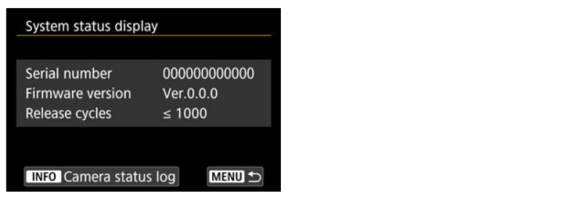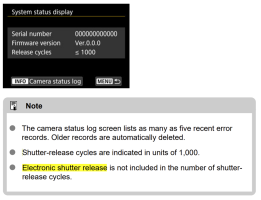This thread is just an FYI for R3 users.
I discovered that the Shutter Count app (available for MacOS) counts the R3’s electronic shutter “actuations/release cycles”. I’ve not used the mechanical shutter once on the camera, but I’ve taken approximately 7,200 Electronic Shutter images. The Shutter Count app reports the shutter count as less than or equal to (<) 8,000.
Interestingly, the R3 itself doesn’t show Electronic Shutter actuations. Going into the R3’s menu (wrench icon, tab 5) and to “System Status Display”, the shutter actuations are shown on my camera as less than or equal to (<) 1,000. This is consistent with my non-use of the mechanical shutter, as actuations are only shown in 1,000-shot increments. In other words, I believe the R3, through its own menu and logging system, is only showing mechanical shutter actuations/release cycles.
This is interesting for two reasons:
1. It shows that Canon’s software is actually recording BOTH Electronic Shutter and Mechanical Shutter actuations, even though you, as the user, are really only meant to know the Mechanical Shutter actuation number (in 1,000-shot increments).
2. Don’t go by Shutter Count’s actuation estimate when reselling the camera and a prospective buyer asks about the camera’s shutter count.
I also found a post on DPReview where an owner of two R5’s encountered this issue while using the Shutter Count app. One of his R5’s was showing both his Electronic Shutter and Mechanical Shutter usage combined, and the other R5 was solely showing his Mechanical Shutter usage.
This individual wrote to the developers of Shutter Count, and the developers responded with the following:
"Unfortunately we can't correct what Canon screwed up. Also, corrupted counters will stay this way even if Canon fixes the bug (which seems to be done in firmware 1.4.0), and future actuations are tracked properly. Please note that if you haven't used the fully electronic shutter, then the counter you get will naturally represent the mechanical one."
You can see the thread here:
https://www.dpreview.com/forums/thread/4616410#forum-post-65717905
I checked my R5, as well, having read the above thread. The Shutter Count app reported my Mechanical Shutter usage accurately (< 3,000); I know it’s accurate because I’ve taken tens of thousands of Electronic Shutter images with my R5, and relatively few Mechanical Shutter images.
Curiously, the R5 does not have the “System Display Status” menu that the R3 has. The only shutter count available through the camera is within the Battery Status menu, and that only shows how many shots have been taken since the last full battery charge.
From what I’ve found online, the “System Display Status” menu is reserved for Pro Bodies; the 1DX, 1DX Mark II, and 1DX Mark III all have the “System Display Status”, too. According to the 1DX and R3 manuals, the “System Display Status” menu’s purpose is to check the camera’s serial number, firmware version, shutter release cycles, and the Error and Caution Log:
https://cam.start.canon/en/C010/manual/html/UG-07_Set-up_0350.html
It’s possible that the same bug in the R5’s firmware (as reported/alleged by the developers of Shutter Count) is present in the R3’s firmware. It’s also possible that Shutter Count has not been updated to properly register the R3 yet, and its current way of reading the shutter count is to combine both Mechanical and Electronic Shutter actuations. Regardless, I thought this information was interesting and decided to pass it along.
I discovered that the Shutter Count app (available for MacOS) counts the R3’s electronic shutter “actuations/release cycles”. I’ve not used the mechanical shutter once on the camera, but I’ve taken approximately 7,200 Electronic Shutter images. The Shutter Count app reports the shutter count as less than or equal to (<) 8,000.
Interestingly, the R3 itself doesn’t show Electronic Shutter actuations. Going into the R3’s menu (wrench icon, tab 5) and to “System Status Display”, the shutter actuations are shown on my camera as less than or equal to (<) 1,000. This is consistent with my non-use of the mechanical shutter, as actuations are only shown in 1,000-shot increments. In other words, I believe the R3, through its own menu and logging system, is only showing mechanical shutter actuations/release cycles.
This is interesting for two reasons:
1. It shows that Canon’s software is actually recording BOTH Electronic Shutter and Mechanical Shutter actuations, even though you, as the user, are really only meant to know the Mechanical Shutter actuation number (in 1,000-shot increments).
2. Don’t go by Shutter Count’s actuation estimate when reselling the camera and a prospective buyer asks about the camera’s shutter count.
I also found a post on DPReview where an owner of two R5’s encountered this issue while using the Shutter Count app. One of his R5’s was showing both his Electronic Shutter and Mechanical Shutter usage combined, and the other R5 was solely showing his Mechanical Shutter usage.
This individual wrote to the developers of Shutter Count, and the developers responded with the following:
"Unfortunately we can't correct what Canon screwed up. Also, corrupted counters will stay this way even if Canon fixes the bug (which seems to be done in firmware 1.4.0), and future actuations are tracked properly. Please note that if you haven't used the fully electronic shutter, then the counter you get will naturally represent the mechanical one."
You can see the thread here:
https://www.dpreview.com/forums/thread/4616410#forum-post-65717905
I checked my R5, as well, having read the above thread. The Shutter Count app reported my Mechanical Shutter usage accurately (< 3,000); I know it’s accurate because I’ve taken tens of thousands of Electronic Shutter images with my R5, and relatively few Mechanical Shutter images.
Curiously, the R5 does not have the “System Display Status” menu that the R3 has. The only shutter count available through the camera is within the Battery Status menu, and that only shows how many shots have been taken since the last full battery charge.
From what I’ve found online, the “System Display Status” menu is reserved for Pro Bodies; the 1DX, 1DX Mark II, and 1DX Mark III all have the “System Display Status”, too. According to the 1DX and R3 manuals, the “System Display Status” menu’s purpose is to check the camera’s serial number, firmware version, shutter release cycles, and the Error and Caution Log:
https://cam.start.canon/en/C010/manual/html/UG-07_Set-up_0350.html
It’s possible that the same bug in the R5’s firmware (as reported/alleged by the developers of Shutter Count) is present in the R3’s firmware. It’s also possible that Shutter Count has not been updated to properly register the R3 yet, and its current way of reading the shutter count is to combine both Mechanical and Electronic Shutter actuations. Regardless, I thought this information was interesting and decided to pass it along.







